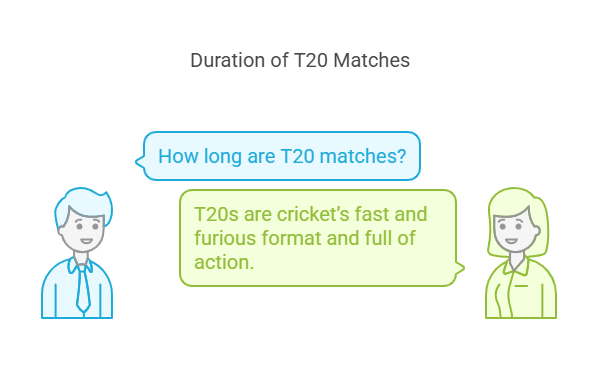How long are T20 matches? T20s are cricket’s fast and furious format and full of action.

Let’s break down the timing, innings and what actually happens between those powerplays and last-over showdowns.
How long is a T20 match in cricket?
Alright, cricket lovers, T20 isn’t just cricket, it’s cricket on espresso. A typical T20 match lasts around 3 to 4 hours, tops. So, how long is a T20 match in cricket? Think of it as the Netflix-binge version of the sport, fast & actionful game.
Each team plays a single innings with 20 overs, which usually takes about 90 minutes per side, plus a 15-20 minute break in between to rest.
The Three Formats of Cricket & How long does a match last?
Cricket comes in three spicy flavors, and each one brings its own kind of actionful game & strategy. Let’s break ‘em down.
1. Test Cricket
Ah, Test cricket, the old-school, five-day-long game that’s all about patience, stamina and serious skills.
- Match Duration: Up to 5 days, 6 hours per day (with lunch & tea breaks)
- Overs: No limit. Each team bats twice (if needed) and tries to bowl out the other side twice.
2. One Day Internationals (ODIs)
Next up: ODIs, the perfect mix of better strategy and action.
- Match Duration: Around 7-8 hours in total. One full day.
- Overs: Each team gets 50 overs to score as much as they can.
You get the full actionplay of both batting and bowling.
3. Twenty20 (T20)
Now for the game of action T20 cricket, where everything happens FAST.
- Match Duration: Just 3-4 hours. Yep, quicker than most dinner parties.
- Overs: Each team gets 20 overs. Blink and you might miss a six.
It’s designed for quick matches and fans love the fast pace, big hits and wild finishes.
TL:DR Cheat Sheet
| Format | Overs per Team | Total Match Time |
| Test | Unlimited | 5 days (6 hrs/day) |
| ODI | 50 overs | 7-8 hours |
| T20 | 20 overs | 3-4 hours |
What are powerplays?
Ah, the powerplays, basically the most important hours of a cricket match. In limited-overs formats like ODIs and T20s, these are specific overs where fielding apply in a tight formation. In T20s, the first 6 overs are the powerplay, where only 2 fielders stay outside the 30-yard circle.
What are free-hits?
Free-hits are like getting a second chance. When a bowler bowls a no-ball (especially for overstepping), the very next delivery is a free-hit. And here’s the kicker, the batter can’t be dismissed, except by run out.
Can games be tied?
Oh yes, a cricket match can absolutely be tied if both teams score the exact same number of runs, no matter how many wickets are lost. But in limited-overs formats like T20s or ODIs, we don’t always leave it there, it starts the Super Over.
When does a cricket match end?

Ah, the million-dollar question. Well, a cricket match ends when one of these things happens:
- All innings are completed: That means both teams have batted the full number of overs or been bowled out.
- One team chases the target: If the team batting second hits the required runs before running out of wickets or overs. Boom, game over, mic drop.
- Overs run out: In limited-overs matches like ODIs or T20s, the match ends when all scheduled overs are bowled.
- Time’s up: In Test matches, if five days pass and neither side has won, it’s declared a draw. Yes, five whole days.
So yeah, cricket matches don’t have a fixed clock-out time.
How long is the break between innings in T20 cricket
Alright, blink and you might miss it, the break between innings in a T20 cricket match is just 20 minutes. Yep, that’s the quick tea time where teams discuss their tactics, switch roles, and prep for the second innings. So, if you’re wondering how long is a T20 match in cricket, the entire game typically lasts about three hours.
During this short break, the fielding team becomes the batting squad (and vice versa), while the crowd grabs snacks and maybe a selfie or two.
ICC Men’s T20 World Cup format, rules & past winners
Alright cricket fam, time to talk about the ICC Men’s T20 World Cup. This isn’t your average match. It’s where nations bring their A-game in just 20 overs. Here’s the full details:
Format
- The tournament usually has 20 teams (as of the 2024 edition).
- It starts with a First Round / Group Stage, where lower-ranked teams fight it out to enter the Super 12s.
- Then comes the Super 12 stage, two groups of six teams each. Each team plays the others in their group.
- The Top 2 from each group move on to the Semi-Finals.
- And then, Finals. Winner takes all, loser takes heartbreak.
Rules to Know
- Each team bats for 20 overs, max.
- One innings per team. No second chances here.
- Bowlers can bowl a max of 4 overs.
- In case of a tie? Super Over a one-over game.
Past Winners (a quick throwback)
| Year | Winner | Runner-Up | Host Nation |
| 2007 | India | Pakistan | South Africa |
| 2009 | Pakistan | Sri Lanka | England |
| 2010 | England | Australia | West Indies |
| 2012 | West Indies | Sri Lanka | Sri Lanka |
| 2014 | Sri Lanka | India | Bangladesh |
| 2016 | West Indies | England | India |
| 2021 | Australia | New Zealand | UAE/Oman |
| 2022 | England | Pakistan | Australia |
Yes, West Indies are out here winning parties.
Cricket and the Olympics

Okay, here’s some great thing going to happen, cricket is FINALLY making a comeback to the Olympics after more than a century. Yup, it’s been MIA since 1900.
The Past
Cricket was played just once in the Olympics 1900 in Paris. Only two teams played. Great Britain vs France. Britain won.
The Comeback
Here’s the sentence with the keyword inserted:
Cricket is officially returning in the Los Angeles 2028 Olympics. Format? T20 cricket, of course. How long is a T20 match in cricket? Short, sweet and perfect for global audiences. Expect big cricketing nations like India, Australia, England, Pakistan, South Africa and newcomers like USA to bring serious heat.
Why the Olympics Wants Cricket Now?
Massive viewership, especially from South Asia (1.5+ billion fans). It’s fast, fun best for Olympic. Also, let’s be real, the US wants to jump in and LA 2028 is the perfect place.
What happens if there is a ‘no result’ finish in a World Cup match?
Ah, “no result” it’s like waiting for a twist. In cricket, especially in World Cup matches, this can be a real buzzkill. So, what actually happens?
First off, a ‘no result’ means the match couldn’t be completed usually because of rain, bad light or other weather issues and each team didn’t face the minimum number of overs required for it. In One Day Internationals (ODIs), that minimum is 20 overs per side.
Here’s what happens next, depending on the stage of the tournament:
In Group Stage Matches:
Both teams get 1 point each, simple as that. No winner, no loser. It can seriously shake up the points table, especially if it’s a high-stakes clash between top teams. Net Run Rate (NRR) might break ties so every ball still counts.
In Knockout Matches (Semi-finals or Final):
If a semi-final or final gets washed out and no result is declared. The ICC usually schedules a reserve day for such big matches. That’s a backup day specifically to finish the game.
If the reserve day also gets washed out in a semi-final, then the team that finished higher in the group stage advances to the final.
In the final, if even the reserve day fails and no result is possible & it can end in a shared trophy. (Like in the 2002 Champions Trophy)
Who will qualify for the final if a knockout game is rained off?
Alright, here’s the inside scoop. When a knockout game (like a semi-final) gets washed out by rain and there’s no result, the team that finished higher in the group stage standings usually goes through to the final.
But wait, there’s more.
Most big tournaments (like the ICC World Cup or T20 World Cup) have reserve days for semi-finals and finals. That means if rain messes up the original day, they’ll try again the next day. Only if the reserve day also gets rained out and then that points table rule kicks in.
So basically:
- Reserve Day? They’ll use it first.
- Still no result? Higher-ranked team from the group stage goes through.
- Tiebreaker options like Net Run Rate (NRR), depending on the tournament rules.
FAQs
What is Cricket?
Cricket is a globally loved sport where two teams compete to score runs and by combining strategy and skill in various formats like Tests, ODIs and T20s.
What is DLS?
DLS (Duckworth-Lewis-Stern) is a mathematical method used in rain-affected cricket matches to fairly adjust target scores based on overs and wickets remaining for both teams.

The beauty of your writing lies not only in the clarity of your ideas but in the way you allow those ideas to breathe and grow. Each sentence feels like a step forward, yet it’s not rushed. There’s time to pause and reflect between the lines, and in that space, the words take on a life of their own. It’s rare to find writing that feels so alive.
Wow, thank you so much for such a thoughtful and kind comment! I’m really glad the writing resonated with you — creating that sense of space and reflection is exactly what I hope to achieve. Your words truly made my day!
Hi there to all, for the reason that I am truly keen of reading this website’s post to be updated daily. It carries fastidious data.
Hi there, just became alert to your blog through Google,and found that it is truly informative. I am gonna watch outfor brussels. I’ll be grateful if you continue this in future.Lots of people will be benefited from your writing.Cheers!
Thank you for any other fantastic article. The place else may anyone get that type of info in such an ideal means of writing? I have a presentation subsequent week, and I’m at the search for such information.
Thank you so much for your kind words! I’m really glad you found the article helpful. For your presentation, feel free to explore the other guides and resources on the blog — there’s plenty of detailed information on cricket techniques, gear, and training tips. Wishing you the best of luck with your presentation next week!